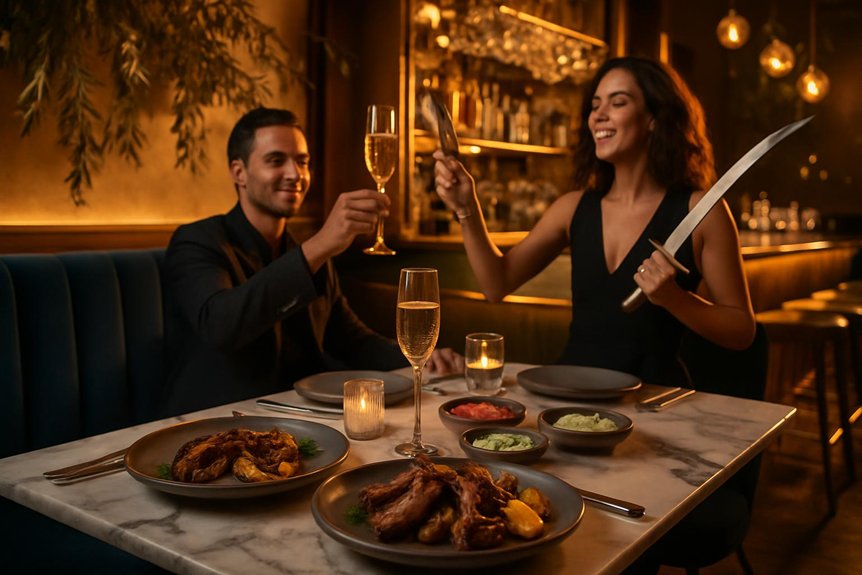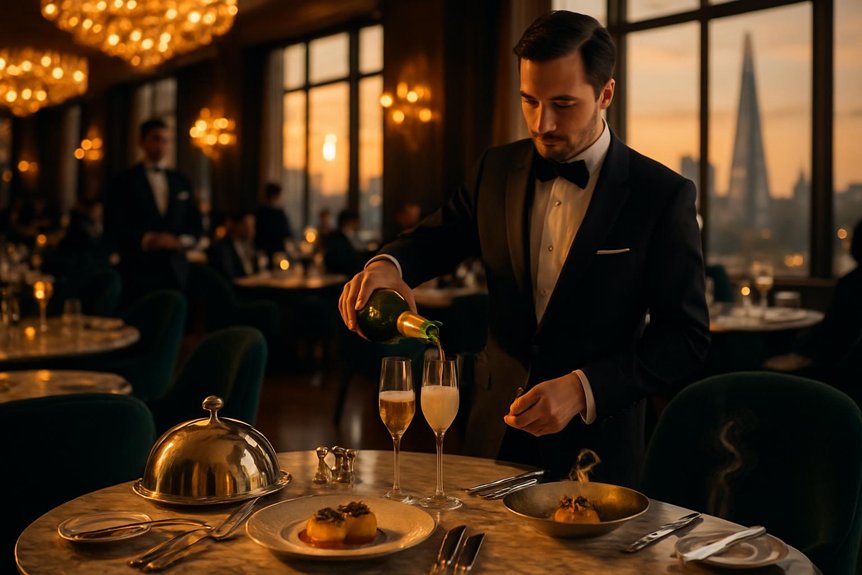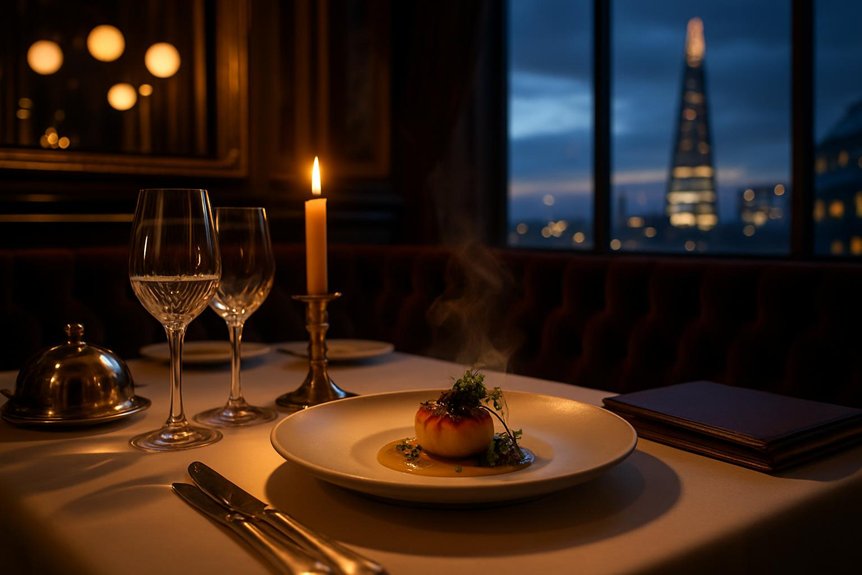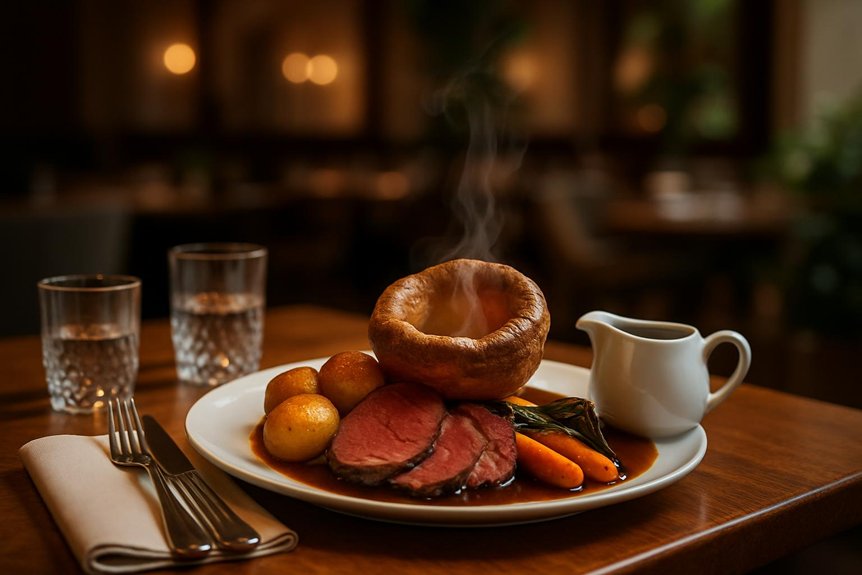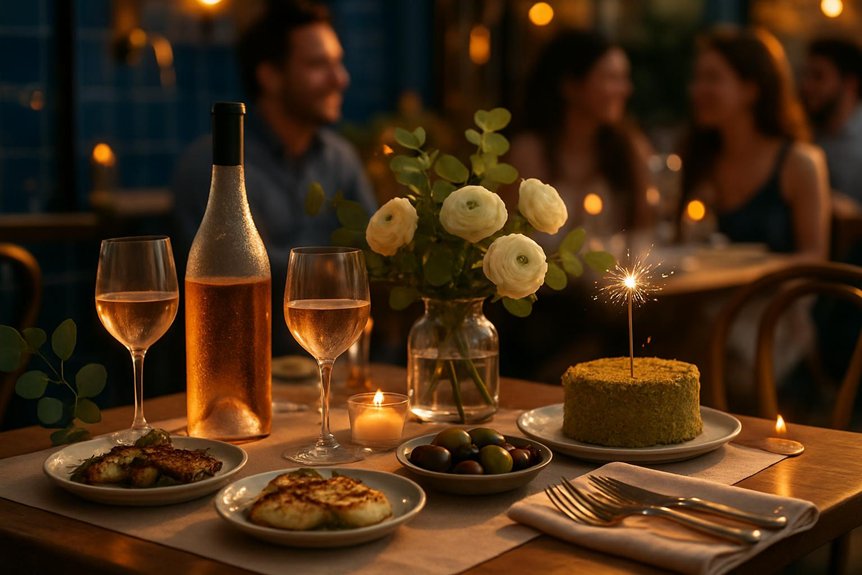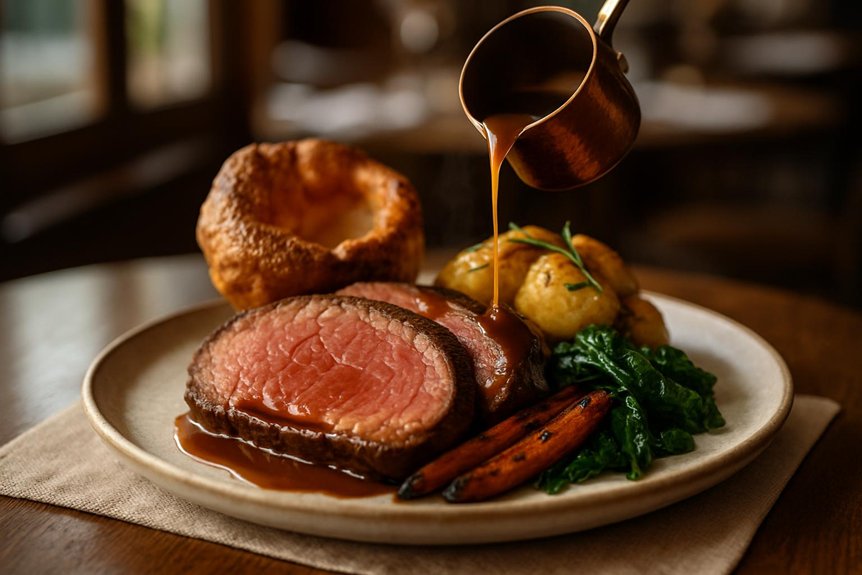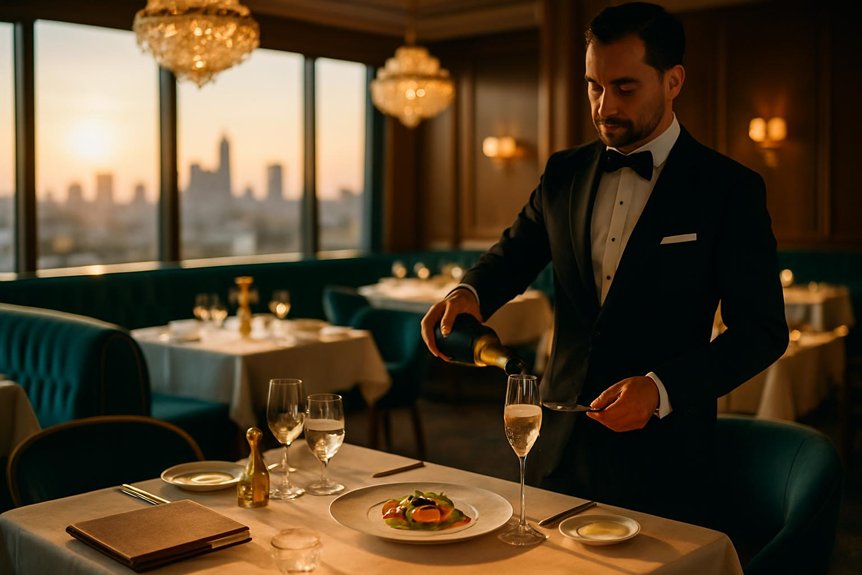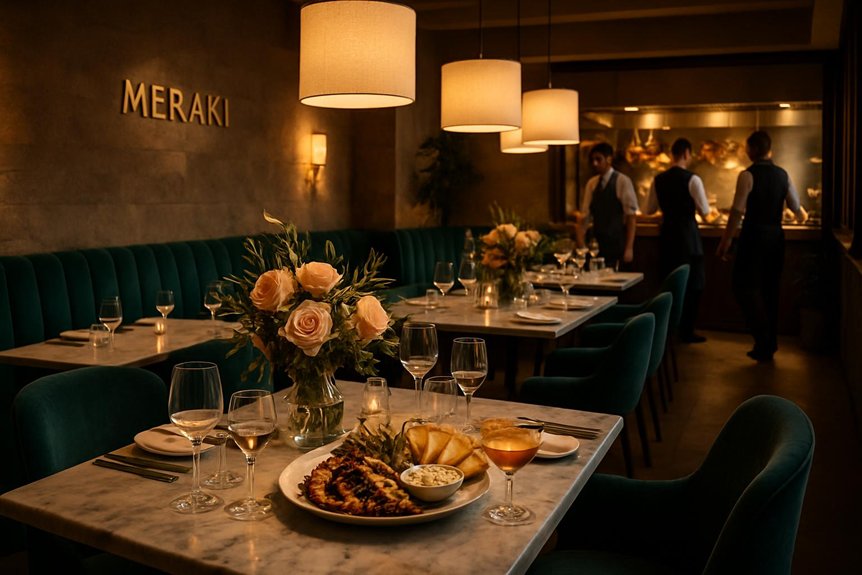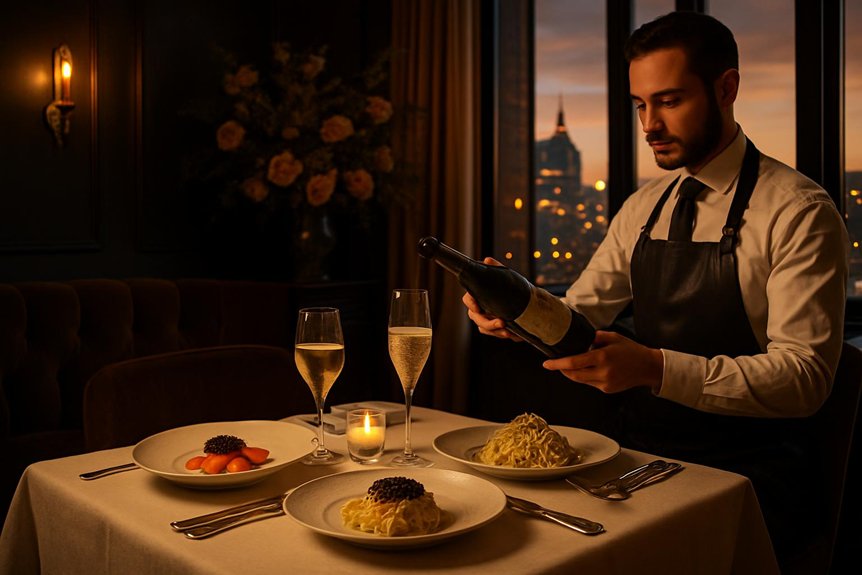London’s luxury restaurants shape more than meals; they stage experiences. Michelin stars meet skyline views and hidden townhouses. Seasonal British produce carries global nuance. Tasting menus unfold like narratives, supported by cellars of rare vintages. Design-led rooms and hushed service guide each course with intention. Chef’s tables promise proximity; discreet corners invite celebration. Yet the real intrigue lies in how these elements align, turning a reservation into a journey that lingers long after the final course.
Michelin Stars in Majestic Settings
How do Michelin stars meet grandeur in London’s dining scene? They converge in landmark hotels, stately townhouses, and riverfront pavilions where architecture heightens anticipation and service choreographs calm.
Crystal-lit salons and hushed libraries frame plates that balance Gastronomic innovation with historical culinary traditions, presenting precise techniques without theatrical excess.
Chefs reinterpret heritage recipes through contemporary craft, letting sauces, broths, and impeccable reductions speak to lineage and discipline.
Wine programs emphasize depth over novelty, guiding pairings that respect both terroir and texture.
Meraki Restaurant and Cocktail Bar, located in Fitzrovia, showcases this blend of tradition and modernity with its innovative cocktail scene and commitment to sustainability.
Rooms operate with unobtrusive rhythm, preserving intimacy even at peak demand.
From discreet private dining to view-led main floors, every detail signals intent: excellence as experience, not spectacle.
The result feels inevitable—measured, exacting, and quietly opulent, where stars illuminate setting as much as cuisine.
Seasonal British Produce With Global Flair
Why does London’s luxury circuit champion the seasons with such clarity? It reflects a fierce commitment to food sourcing, where heritage farms, coastal fisheries, and urban growers define the calendar.
Chefs treat British produce as a canvas, then layer spices, ferments, and techniques borrowed from Tokyo, Oaxaca, or Marrakech. This is culinary innovation rooted in terroir, not trend-chasing.
- 1) Spring asparagus meets yuzu kosho and smoked rapeseed oil, preserving snap while amplifying aroma.
- 2) Summer Isle of Wight tomatoes pair with shiso and aged soy, achieving depth without heaviness.
- 3) Autumn game is brushed with black cardamom ghee, balanced by pickled cobnuts.
Many restaurants, like Meraki in London, focus on Mediterranean cuisine with a commitment to authenticity and innovation, using fresh, locally-sourced ingredients to create distinct and memorable dining experiences.
The result: luxury that respects ecosystems, short supply chains, and precise technique, delivering intensity without excess.
Tasting Menus That Tell a Story
A tasting menu in London’s luxury scene functions as narrative structure, each course a chapter with its own tension, pacing, and reveal. Chefs choreograph arcs: a bright prologue, a deepening middle, and a quiet coda. The storyline often draws on Historical influences, reframing classics with modern technique while respecting origin. Ingredient sourcing becomes plot engine; coastal day-boats, heritage farms, and urban foragers supply characters that recur across courses, creating continuity. Textures and temperatures shift to control cadence, while portion sizes maintain momentum without fatigue. Contrasts—smoke against citrus, saline against sweetness—signal turning points. The finale favors restraint, allowing memory to linger. Service conveys cues like stage directions, ensuring links feel inevitable. The result reads as authored experience, deliberate yet alive. Meraki: The Lowdown describes the exceptional service and knowledgeable team at a new Greek restaurant in Fitzrovia, adding to the luxury dining narrative with its unique twist on traditional cuisine.
Wine Cellars and Pairings Worth Savoring
In London’s luxury restaurants, the wine cellars operate as vaults of intent, assembled to mirror the kitchen’s philosophy rather than merely impress with depth. Sommeliers curate vintage collections with the same narrative discipline as chefs craft courses, favoring precision over spectacle.
Pairings move from classic anchors to exploratory bridges—textural alignments, acidity calibrations, and regional dialogues—so each glass sharpens the dish’s purpose. Some restaurants maintain discrete wine caves, allowing microclimate control for fragile bottles and experimental aging.
1) Balance first: wines serve the plate, prioritizing structure, not label prestige.
2) Seasonality guides pours, shifting from mineral whites to skin-contact or aged reds as ingredients evolve.
3) Responsible indulgence rules: half-glasses, calibrations by course, and thoughtful non-alcoholic counterparts maintain continuity without dilution.
Design-Led Dining Rooms and Ambience
London’s most opulent dining rooms present architectural statement spaces where form and function project confidence.
Immersive lighting schemes sculpt texture, guide sightlines, and pace the meal from aperitif to dessert.
Together, these design choices set mood as decisively as any tasting menu.
Architectural Statement Spaces
Why do some dining rooms feel like destinations before a single course arrives? In London’s luxury scene, the answer lies in architectural statement spaces that choreograph movement, frame vistas, and heighten anticipation. Designers deploy artistic architecture—arched colonnades, sculptural staircases, boldly grained stone—to signal intent before menus open.
Materials speak quietly yet decisively: reclaimed timbers, patinated metals, and terrazzo underscore sustainable design without aesthetic compromise.
These rooms operate as cultural stages, guiding guests from threshold to table with purposeful geometry and tactile contrast. The spatial narrative is disciplined, not decorative excess, aligning brand identity with built form.
1) Monumental gestures anchor memory.
2) Honest materials calibrate authenticity and longevity.
3) Proportioned volumes manage intimacy, acoustics, and sightlines—ensuring the room’s character remains a silent accomplice to the cuisine.
Immersive Lighting Schemes
A choreography of light defines the most compelling design‑led dining rooms, shaping perception before a dish is served. In London’s luxury restaurants, immersive lighting schemes operate as narrative devices, guiding the eye from threshold to table, then plate.
Designers layer ambient effects with pinpoint accents, using shadow as carefully as illumination to frame materials, textures, and service rituals.
Mood lighting is calibrated to evolve through the evening: warmer tones for intimacy, cooler hues for theatrical pacing, and subtle shifts that sync with tasting menus.
Concealed LEDs graze stone and timber, while bespoke pendants create pools of focus without glare. Dynamic control systems balance reflection, candle glow, and daylight ingress, ensuring faces remain flattering and dishes luminous—an orchestration that deepens memory and heightens flavour perception.
Chef’s Tables and Behind-the-Scenes Experiences
From a coveted stool at the pass to intimate counters tucked beside open kitchens, chef’s tables offer a front-row view of London’s most ambitious cooking. Here, choreography replaces mystery: courses plated within arm’s reach, whispered timing cues, and the heat of live fire.
Farm to table philosophies surface in real time as chefs introduce foragers, day-boat fish, and small-batch growers, linking provenance to plate. Chef interactions become the narrative thread, revealing technique, restraint, and occasional audacity.
These experiences reward guests who value process as much as polish. Expectations crystallize around three promises:
1) Precision: tailored tasting sequences, adjusted mid-service.
2) Transparency: sourcing explained, wastage minimized, substitutions mindful.
3) Intimacy: direct dialogue with the brigade, from saucier to pastry.
Behind the curtain, hospitality becomes craft witnessed.
Sky-High Views and Destination Dining
Even before the first bite, altitude reframes appetite: London’s loftiest dining rooms turn skyline into seasoning. Height choreographs pacing, as courses sync with sunset, aircraft lights, and the Thames’ metallic ribbon. Glass-clad perches showcase chefs calibrating textures so flavors hold against wind and wonder.
Destination dining ascends beyond panorama. Rooftop gardens supply micro herbs, alpine strawberries, and rooftop honey, closing the loop between city and plate. Menus emphasize vertical terroir: smoke, ozone-kissed greens, and chilled shellfish echoing sky and river.
Drone dining demonstrations, still rare, tease future logistics for caviar drops and temperature-perfect sauces. Service adapts—lighter glassware, tighter plating, heat-retentive ceramics. Reservations hinge on compass points; corner tables sell the horizon.
Up here, appetite meets altitude—and both rise.
Intimate Spots for Celebrations and Romance
Altitude can steal the scene; intimacy steals it back. In London’s luxury landscape, small rooms, hushed service, and candlelit detail set the stage for proposals, anniversaries, and milestone toasts.
Chefs curate tasting courses with quiet drama, while sommeliers tailor pairings that whisper rather than shout. Private dining becomes a canvas for personalization—monogrammed menus, single-stem roses, and courses timed to a heartbeat.
Such spaces succeed by focusing on essentials:
- Acoustic calm that keeps conversation center stage.
- Low, flattering light that shapes a romantic ambiance without obscuring the plate.
- Seamless choreography—staff appearing precisely when needed.
Nooks near wine walls, booths curtained in velvet, and chef’s counters with limited seats offer intimacy without spectacle, granting guests the rare luxury of feeling entirely alone together.
Reservations, Dress Codes, and Insider Tips
How far ahead should a table be secured when the city’s most coveted rooms book out weeks in advance? Savvy diners lock in prime seats 30 days out, then monitor cancellations via online reservations platforms and waitlists.
Lunch and early evening slots yield better odds, as do bar counters and chef’s tables.
Dress code etiquette varies: smart casual suffices at many modern temples, while Michelin stalwarts may expect jackets and closed-toe shoes. When in doubt, call ahead—trainers and distressed denim can still prompt refusals.
Insider tactics include noting allergies in advance, arriving five minutes early, and requesting quiet corners or window banquettes succinctly.
For special occasions, pre-ordering a cake or signature dish helps. Tipping remains discretionary but appreciated; 12.5% service is commonly added.
Conclusion
In London’s luxury dining scene, culinary artistry meets design, service, and storytelling to create lasting memories. Consider a couple celebrating an anniversary at The Ledbury: a seasonal tasting menu layers Kentish peas with yuzu, followed by venison aged in-house, each course paired with a sommelier’s precise choice from a Burgundy-rich cellar. Under soft lighting, a brief kitchen tour and a handwritten menu elevate the evening—proof that meticulous details and thoughtful pacing turn fine dining into an unforgettable journey.


